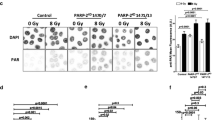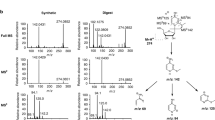Abstract
SCE induction in synchronised CHO cells treated with methyl methane sulphonate (MMS) in G1 was studied over successive pairs of cell cycles by introducing bromodeoxyuridine (BrdU) at consecutive G1 stages. When individual cell cycle SCE values were calculated from the data, anomalous results were obtained with ratios of 1.0∶1.8∶2.1 for the first three cycles but a negative value for the fourth cycle. Further studies using different BrdU concentrations showed that MMS induced SCEs were reduced by values exceeding 50% in DNA containing high levels of incorporated BrdU. This reduction was dose dependent and accounted for the anomalous results obtained over successive cycles. Lesions leading to chromatid exchanges were also reduced by the same mechanism. SCEs induced by UV irradiation were also decreased but those induced by the cross-linking agent nitrogen mustard (HN2) remained unaffected. The results indicate that not only are SCE lesions induced by MMS, UV or HN2 expressed independently of the “spontaneous” SCEs induced by BrdU but that SCE lesions are multiple in nature. Mechanisms by which SCE lesions could be repaired in BrdU containing DNA are discussed. SCE lesions in MMS treated cells arrested in G1 with arginine deprived medium (ADM) are repaired without the presence of BrdU in the DNA. An opposite effect is seen however in the control cells, where SCEs are increased with time spent in ADM arrest. These interactions between the effects of MMS, BrdU and ADM arrest are discussed.
Similar content being viewed by others
References
Davidson, R.L., Kaufman, E.R., Dougherty, C.O., Ouellette, A.M., DiFolco, C.H., Latt, S.A.: Induction of sister chromatid exchanges by BUdR is largely independent of the BUdR content of DNA. Nature (Lond.) 284, 74–76 (1980)
Ikushima, T., Wolff, S.: Sister chromatid exchanges induced by light flashes to 5-bromodeoxyuridine and 5-iododeoxyuridine substituted Chinese hamster chromosomes. Exp. Cell Res. 87, 15–19 (1974)
Kaufman, E.R., Davidson, R.L.: Bromodeoxyuridine mutagenesis in mammalian cells is stimulated by purine deoxyribonucleosides. Somatic Cell Genet. 5, 653–663 (1979)
MacRae, W.D., MacKinnon, E.A., Stich, H.F.: The fate of UV-induced lesions affecting SCEs chromosome aberrations and survival of CHO cells arrested by deprivation of arginine. Chromosoma (Berl.) 72, 15–22 (1979)
Makino, F., Munakata, N.: Excision of uracil from bromodeoxyuridine-substituted and UV-irradiated DNA in cultured mouse lymphoma cells. Int. J. Radiat. Biol. 36, 349–357 (1979)
Margison, G.P., O'Connor, P.J.: Biological implications of the instability of the N-glycosidic bond of 3-methyldeoxyadenosine in DNA. Biochem. biophys. Acta. (Amst.) 331, 349–356 (1973)
Mazrimas, J.A., Stetka, D.G.: Direct evidence for the rate of incorporated BUdR in the induction of sister chromatid exchanges. Exp. Cell Res. 117, 23–30 (1978)
Miller, R.C., Aronson, M.M., Nichols, W.W.: Effects of treatment on differential staining of BrdU labelled metaphase chromosomes: three way differentiation of M3 chromosomes. Chromosoma (Berl.) 55, 1–11 (1976)
Ockey, C.H.: Differences between “spontaneous” and induced sister-chromatid exchanges with fixation time and their chromosome localisation. Cytogenet. Cell Genet. 26, 223–235 (1980)
Perry, P., Wolff, S.: New Giemsa method for the differential staining of sister chromatids. Nature (Lond.) 251, 156–158 (1974)
Regan, J.D., Setlow, R.B.: Two forms of repair in the DNA of human cells damaged by chemical carcinogens and mutagens. Cancer Res. 34, 3318–3325 (1974)
Schempp, W., Krone, W.: Deficiency of arginine and lysine causes can increase in the frequency of sister chromatid exchanges. Hum. Genet. 315–318 (1979)
Wolff, S.: Chromosomal effects of mutagenic carcinogens and the nature of the lesions leading to sister-chromatid exchange. In: Mutation induced chromosome damage in man (H.J. Evans and D.C. Lloyd, eds.), pp. 208–215, Edinburgh: University Press 1978
Wolff, S., Perry, P.: Differential giemsa staining of sister chromatids and the study of sister chromatid exchange without autoradiography. Chromosoma (Berl.) 48, 341–353 (1974)
Author information
Authors and Affiliations
Rights and permissions
About this article
Cite this article
Ockey, C.H. Methyl methane-sulphonate (MMS) induced SCEs are reduced by the BrdU used to visualise them. Chromosoma 84, 243–256 (1981). https://doi.org/10.1007/BF00399135
Received:
Issue Date:
DOI: https://doi.org/10.1007/BF00399135




